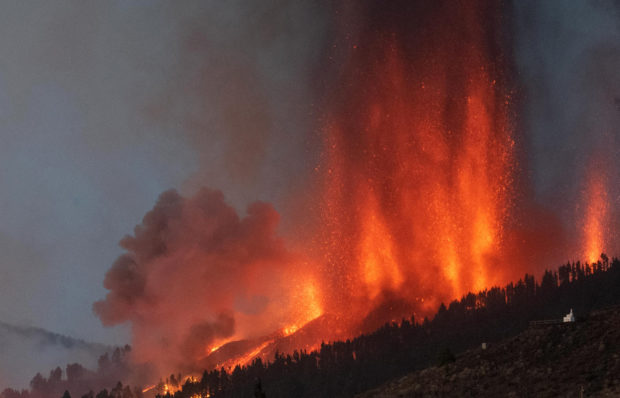La Palma flights resume as volcanic lava reaches sea

FILE PHOTO: Mount Cumbre Vieja erupts in El Paso, spewing out columns of smoke, ash, and lava as seen from Los Llanos de Aridane on the Canary island of La Palma on September 19, 2021. Cumbre Vieja straddles a ridge in the south of La Palma island and has erupted twice in the 20th century, first in 1949 then again in 1971. (Photo by DESIREE MARTIN / AFP)
Spain — A commercial flight flew into La Palma in the Canary Islands on Wednesday, the first since an erupting volcano forced a weekend airport closure, the plane landing hours after rivers of molten lava reached the sea.
The dramatic eruption which began 10 days ago, has forced thousands out of their homes, with the lava destroying hundreds of homes, businesses, and huge swathes of banana plantations.
Fears that the lava’s entry into the ocean would cause further harm to the local population by generating clouds of toxic gas were allayed earlier Wednesday as a brisk wind blew the vapors out to sea.
Although the volcano is still erupting, La Palma’s airport resumed operations on Wednesday, with a first flight from the neighboring island of Tenerife landing at 1230 GMT.
“Flights to #LaPalma have resumed,” local airline Binter tweeted, saying it was due to “an improvement in security conditions” on the tiny island which has an area of 708 square kilometers (273 square miles).
Article continues after this advertisementThe airport shut down on Saturday due to the accumulation of ash. Although it reopened 24 hours later, all flights had remained canceled.
Article continues after this advertisementLa Cumbre Vieja lies about 15 kilometers (nine miles) west of the airport as the crow flies, although the lava has only spilled down the western side of the volcano.
Molten lava cascading over cliffs
Late on Tuesday, a vast stream of white-hot lava poured into the sea, sending plumes of acid fumes into the air that experts said could irritate the skin, eyes, and respiratory tracts, possibly causing breathing difficulties.
But good weather conditions had reduced the risk, Ruben Fernandez of the Pevolca volcanic emergency committee told Spain’s public radio.
“We have a strong wind in the area which is blowing the cloud of gases towards the sea, so the risk for the local population is much lower” than expected, he said.
La Cumbre Vieja straddles a southern ridge in La Palma island, which is home to 85,000 people, with the September 19 eruption forcing some 6,000 to flee as the lava slowly edged towards the western coastline.
When it arrived, dramatic television images showed rivers of molten rock cascading off a cliff into the water, churning up huge clouds of vapor and gas.
Since early on Monday, some 300 residents in the nearby town of Tazacorte have been under home confinement to avoid injury from the gases.
Authorities also set up an exclusion zone of 3.5 kilometers (two miles) around the site, which also extends two nautical miles out to sea.
‘Tremendous devastation’
La Palma has been declared a natural disaster zone, with the lava scorching its way across more than 268 hectares (662 acres) of land and destroying 656 buildings, according to the European Union’s Copernicus Earth Observation Program.
So far, nobody has died or been injured.
But Canary Islands regional head Angel Victor Torres said the impact on land and property had been vast.
“We are talking about lava flows that are 600 meters wide. In all that area, there’s nothing left. The devastation is tremendous,” he told COPE radio on Wednesday.
The banana industry “has suffered tremendous damage, we are talking about a third of the banana production of the entire Canary Islands,” he said, indicating the current harvest “has been completely lost.” The local banana plantations make up one of the island’s key industries.
Madrid on Tuesday released 10.5 million euros ($12.3 million) in aid for those left homeless by the volcano.
Last week, Torres had estimated the damage would exceed 400 million euros.
Experts believe the eruption could last for several weeks, or even months.